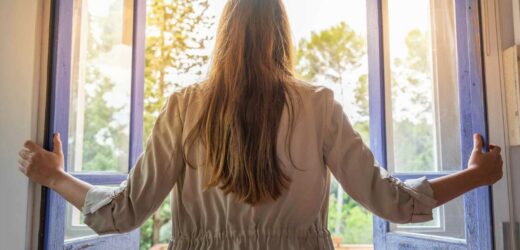TO keep ourselves and each other safe while we’re out and about this autumn and winter, we can take a few simple steps.
We know that Covid-19 is an airborne virus, which means it spreads when an infected person breathes, coughs or sneezes out particles that contain it, and those particles are breathed in by others.
While larger droplets will fall to the ground, and staying socially distanced can help you avoid being infected by them, finer particles called aerosols can stay suspended in the air, and they can build up in rooms that aren’t ventilated.
Good ventilation can substantially reduce the risk of passing on Covid-19 indoors – so this autumn and winter, try throwing open your windows, especially when you have visitors.
Open windows and doors at opposite sides of your room or home. This will provide a good flow of fresh air (known as cross ventilation). Open them wide for ten minutes at a time. If you’ve got guests over, let fresh air in before, during and after their visit.
If windows have openings at both the top and the bottom (such as sash windows), using just the top opening will help incoming fresh air warm up as it mixes with room air, reducing draughts. Make sure trickle vents or grilles are open and not blocked
It’s even better to take your socialising outside as much as possible. Minimise the amount of time you spend indoors with people you do not live with. Meet friends in pub gardens and parks or take blankets out into the garden.
Cover up where it’s crowded
Since July 19, we haven’t had to wear a face covering in shops and on public transport by law, but lots of us still take one out with us when we’re out and about.
It’s important to still wear a face covering when you’re in enclosed or crowded spaces, as a way of protecting everyone, not just ourselves.
Around one in three people who have Covid-19 won’t feel any symptoms, and masks are a way of preventing the virus from spreading from person to person – even if we don’t know we have it.
To work properly, your mask should cover your nose and mouth, be made from at least two layers of washable, breathable fabric, and fit securely – which means items like bandanas are often not effective.
Remember, face shields don’t provide the same protection as a proper face covering, as they don’t filter out smaller airborne particles.
The UK Government recommends that people should carry on wearing face coverings wherever they’re needed, unless you’re exempt or a child under 11.
You might also find that you’ll still be asked to use them in some public places, such as on buses and trains and in shops – so it’s not time to start leaving the house without your mask just yet.
Keep on top of testing
The heroes of NHS Test and Trace are doing a great job of keeping the spread of the virus at bay. But for the service to work properly, we all need to carry on getting tested – regularly at home, even if you don’t have symptoms, or with a PCR test if you do.
To help stop us spreading Covid-19 when we don’t have symptoms, the UK Government is encouraging everyone to take regular rapid lateral flow device (RLFD) tests, even if they don’t feel ill.
Over 157 million RLFD tests have been taken in England so far, and have found over 851,000 positive cases of Covid-19.
You might be able to get the tests from your place of education or employment. If not, you can order a kit online at Gov.uk or at NHS.uk/GetTested or pick one up at a pharmacy. You’ll need to register for a collect code first, at Gov.uk/get-collect-code or by calling 119. Present the code at the pharmacy.
It’s important to report the result of your test, even if negative, at Gov.uk/report-covid19-result or by calling 119.
If your RLFD test comes back positive, you’ll need to self-isolate immediately, and order a PCR test. You’ll also need to take the test if you develop symptoms, however mild, if a close contact has tested positive, or if you’ve been told to by NHS Test and Trace.
You may wish to take a free RLFD test if you feel there will be a period of high risk that day, either to yourself or others. Parents should make sure their children take a test before and on return to school after the half-term holidays.
You can order a home-testing kit at Gov.uk/getcoronavirus-test or book a test at a walk-in or drive-through site.
If you’re on a low income and have been asked to self-isolate by NHS Test and Trace, or because you or your child have tested positive for Covid-19 via a PCR test, you might be eligible for a payment of £500, to help cover any lost income.
What the experts say…
Dr Jenny Harries, chief executive of the UK Health Security Agency
“Get a PCR test straight away if you have any Covid symptoms and if you’re meeting people indoors, open doors and windows to let fresh air in. The best way to protect yourself and others is to get the vaccine, so do come forward if you are eligible.”
UK Government chief scientific adviser Sir Patrick Vallance
“While vaccines are offering us good protection, Covid-19 is still with us. Stay safe this winter by taking steps like wearing a face covering in crowded indoor spaces, testing regularly and ventilating rooms where possible. By doing this, we can reduce the spread of the virus and keep ourselves and others safer.”
Dr Susan Hopkins
“Lateral flow devices are effective at finding people with high viral loads who are most infectious and most likely to transmit the virus to others.”
Source: Read Full Article




